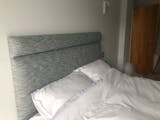As parents, it’s natural to want the best for our little ones. We spend hours researching the best prams, cribs and car seats to keep our babies safe. However, in recent years, there has been a growing trend in the parenting world: floor beds for infants. While floor beds have their benefits, many parents wonder if they are safe for their babies. In this article, we will explore the benefits and potential risks of floor beds for infants.
What is a Floor Bed?
A floor bed is exactly what it sounds like - a bed that sits directly on the floor, without a box spring or bed frame. Floor beds for infants typically consist of a low mattress or futon placed directly on the floor, often surrounded by soft, child-friendly decor.
Benefits of a Floor Bed
Many parents choose to use a floor bed for their infants for several reasons:
- Promotes independent sleeping: Floor beds give infants the freedom to move around and explore their sleeping environment. Unlike cribs, which can feel confining, floor beds provide a sense of independence that can help infants learn to self-soothe and sleep through the night.
- Encourages movement: Infants who sleep on a floor bed are free to move around as they please. This can help with the development of gross motor skills, as they learn to crawl, roll over, and sit up on their own.
- Easier night-time feedings: When an infant is sleeping on a floor bed, parents can more easily tend to their needs during night-time feedings. Without the need to bend over the side of a crib, parents can simply sit or lie down next to their baby on the floor.

Potential Risks of a Floor Bed
While there are benefits to using a floor bed for infants, there are also potential risks to consider:
- Suffocation: The biggest concern with floor beds for infants is the risk of suffocation. Infants who are too young to roll over on their own or have not yet developed strong neck muscles can easily become trapped face down in a soft mattress or bedding.
- Entrapment: Infants who are able to roll over can become trapped between the mattress and the wall or other objects in the room. This can lead to injury or suffocation.
- Falls: Because floor beds are low to the ground, there is a risk of falls if an infant rolls off the bed. This can be especially dangerous if there are hard objects or furniture nearby.
- Overheating: Infants who are sleeping on a floor bed may be more prone to overheating, as the bed is closer to the floor and may not allow for proper air circulation.
Safety Precautions for Floor Beds
To minimise the risks associated with floor beds for infants, there are several safety precautions that parents should take:
- Use a firm mattress: To reduce the risk of suffocation, it’s important to use a firm mattress on the floor bed. Soft mattresses or bedding can conform to an infant’s face, making it difficult to breathe.
- Use breathable bedding: Avoid using heavy blankets, pillows, or other bedding that can pose a suffocation risk. Instead, use lightweight, breathable materials to keep your baby comfortable.
- Create a safe sleeping environment: Make sure that there are no objects nearby that could pose an entrapment or suffocation risk, such as walls, furniture, or toys. It’s also important to keep the sleeping area free of loose objects or clutter.
- Supervise your baby: It’s important to supervise your baby when they are sleeping on a floor bed. This will allow you to quickly respond if your baby rolls off the bed or becomes trapped.
- Wait until your baby is ready: It’s important to wait until your baby is developmentally ready to sleep on a floor bed. Infants who are not yet able to roll over on their own or who have weak neck muscles should sleep in a crib or bassinet.
- Consider a bed rail: For infants who are able to roll over but may still be at risk of falling off the bed, a bed rail can help prevent accidents.
- Install a smoke detector and carbon monoxide detector: Make sure to have working smoke detectors and carbon monoxide detectors installed in the room where your baby will be sleeping.
It’s generally recommended that infants sleep in a crib or bassinet that meets current safety standards if you want to mitigate any potential risks. It’s also recommended that infants should not share a bed with adults or other children, as this can increase the risk of suffocation or entrapment. If you choose to use a floor bed for your infant, it’s important to follow the safety precautions listed above and consult with your paediatrician to ensure that it’s a safe option for your baby.

Floor Beds Work Wonders for Infants
Floor beds for infants can be a great option for parents who want to promote independent sleeping and encourage movement. However, it’s important to consider the potential risks and take safety precautions to minimise them. Parents should always use a firm mattress, breathable bedding, and create a safe sleeping environment. Supervising your baby and waiting until they are developmentally ready to sleep on a floor bed are also important considerations. Ultimately, it’s up to parents to decide what sleeping arrangement is best for their baby and family.
Choosing the right sleeping arrangement for your child can be difficult, so if you have any questions about floor beds or other options, please contact our team at Endurance Beds today.







